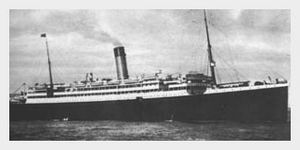SS Laurentic (1908)
Coordinates: 55°15′43″N 6°49′05″W / 55.262°N 6.818°W
 SS Laurentic (1908) | |
| Career | |
|---|---|
| Name: | SS Laurentic |
| Owner: | White Star Line |
| Ordered: | 1907 |
| Builder: | Harland and Wolff |
| Yard number: | 394 |
| Launched: | 1908 |
| Maiden voyage: | 29 April 1909 |
| Fate: | Struck two mines and sank, 25 January 1917 |
| General characteristics | |
| Tonnage: | 14,892 Gross Register Tonnage |
| Length: | 565 ft (172 m) |
| Beam: | 67 ft 3 in (20.50 m) |
| Decks: | 3 |
| Installed power: | Triple-expansion steam engines driving outboard propellers, with low-pressure turbine driving the center propeller. Total 11,000 indicated horsepower. |
| Propulsion: | Triple propeller installation |
| Speed: | 16 kn (30 km/h; 18 mph) |
| Capacity: | 1st Class: 230; 2nd Class: 430; 3rd Class; 1,000 |
SS Laurentic was a British ocean liner of the White Star Line.
The Dominion Line steamship company operated liners on the Liverpool-Canada route in the late 1800s and early 1900s. Their ships had become outdated, so in 1907 two new liners were ordered from Harland and Wolff, the SS Alberta and SS Albany. However, while they were being built they were transferred to the White Star Line and with them the White Star Line itself entered the Canadian passenger trade.[1]
The Alberta was renamed the Laurentic and Albany became the Megantic.[1] At the time, the two were the largest ships yet built for Canadian service and were used as a form of full-scale experiment to decide on the machinery for the Olympic and her sisters, the Megantic being a conventional twin-screw ship with quadruple expansion engines while the Laurentic, with the same hull and boiler power, was given three screws and engines of a revolutionary design.[2]
Laurentic was launched in 1908 and entered service between Liverpool and Montréal on 29 April 1909. She normally served on the Liverpool-Canada route, and gained notoriety in the capture of murderer Hawley Harvey Crippen, in which Chief Inspector Walter Dew of the Metropolitan Police used the Laurentic's speed to arrive in Canada before the fleeing suspect on the SS Montrose.
Being in Montréal when the Great War began, Laurentic was immediately commissioned as a troop transport for the Canadian Expeditionary Force. After conversion to armed merchant cruiser service in 1915, she struck two mines off Lough Swilly in the north of Ireland on 25 January 1917 and sank within an hour. Only 121 of the 475 aboard survived.
In addition to her passengers and crew, the ship was carrying about 35 tons of gold ingots stowed in its second class baggage room. At the time the gold was valued at £5 million, approximately £250 million in 2007. Royal Navy divers made over 5,000 dives to the wreck between 1917 and 1924 and recovered all but about 1% of the ingots. Still to this day 22 bars of gold remain on the sea bed, perhaps under parts of the hull, the last of the gold recovered by the Royal Navy was some 10 metres (33.8 feet) under the sea bed, thus the remaining gold would be difficult to reach. [3]
References
| |||||||||||
External links
cs:SS Laurentic (1908) de:Laurentic (1909) fr:SS Laurentic (1909)
